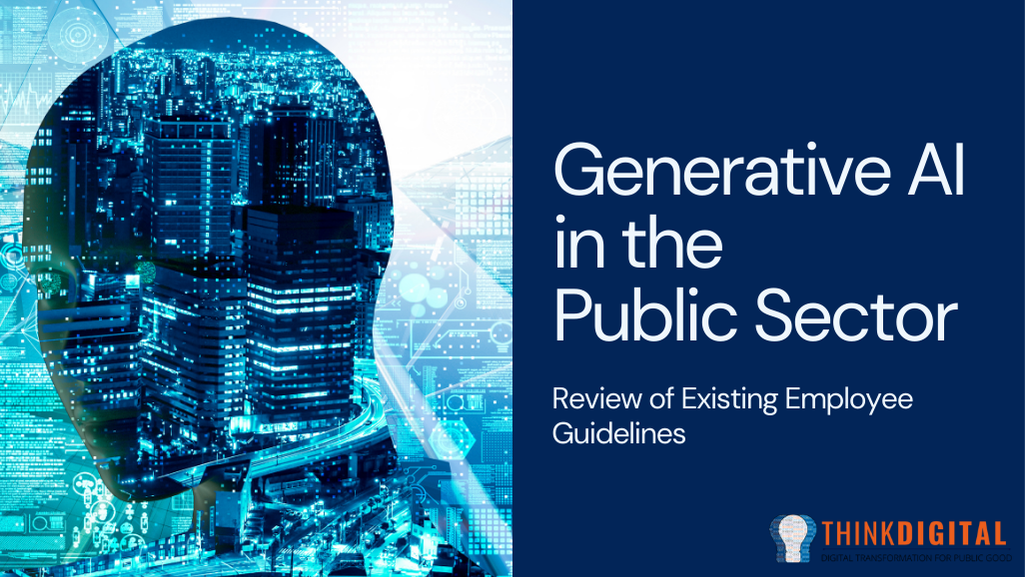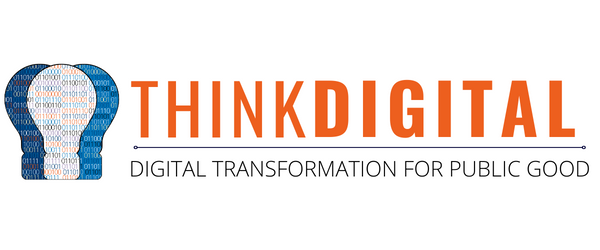Generative AI in the Public Sector: Review of Existing Employee Guidelines
May 31, 2024
By Jacob Danto-Clancy, Digital Policy Analyst, Think Digital
As Generative AI continues to evolve and is further integrated into public sector operations in Canada and around the world, it’s important to understand how different jurisdictions and early adopters are governing its use by their workforce. We recently completed an environmental scan that was commissioned by The Regional Municipality of York (in the Greater Toronto Area) as part of their efforts to better understand potential use cases for Generative AI. We thank York Region for their willingness to allow us to share this research publicly in hopes that it contributes to what is a still nascent, but fast-growing body of knowledge around the use of these technologies in the public sector. Click here to read the full report including the nine case studies we identified from Canada and around the world.

Source: Canva
Report Overview
The environmental scan examines nine case studies that illustrate the current landscape of generative AI guidelines for employee and organizational use across various levels of government. We selected three case studies for each of the three categories of Municipal/Local, Canadian, and International. The case studies selected were as follows:
Municipal/Local
- Generative AI Guidelines, The City of San Jose.
- GenAI Guidance for Local Authorities, London Office of Technology and Innovation (LOTI).
- Interim Guidelines for Using Generative AI, City of Boston.
Canadian
- Guide on the use of generative artificial intelligence, Treasury Board of Canada Secretariat (TBS).
- Generative artificial intelligence (AI) – ITSAP.00.041, Canadian Centre for Cyber Security (CCCS).
- Principles for responsible, trustworthy and privacy-protective generative AI technologies, Office of the Privacy Commissioner of Canada (OPC).
International
- Initial advice on Generative Artificial Intelligence in the public service, New Zealand.
- Guidelines For Staff on The Use of Online Available Generative Artificial Intelligence Tools, European Commission.
- Gen AI framework for HM Government, Central Digital and Data Office (CDDO), United Kingdom.
Central Themes Across Generative AI Guidelines
The resounding attitude of the guidelines could be compared to a “yellow light” approach—to proceed, but with caution. Moreover, what has been true for public sector agencies across jurisdictions when it comes to all things AI up to this point holds for generative AI too: there is a desire to leverage the benefits responsibly, without sacrificing ethical standards or societal values. And, interestingly, the overall tone of the case studies is not simply one of resignation to the inevitable, but is closer to something like cautious curiosity, or what could be called “sober opportunism”.
In other words, many of the guidelines recognize that there are gains to be captured if guidance can permit, instead of prohibit, employee use of generative AI. Several of the guidelines operate as an open call to staff to explore generative AI use as part of a low-risk, stratified integration of these tools/capacities into everyday workflows and functions. Therefore, most of the guidelines serve the twofold purpose of acknowledging the inherent risks of generative AI, while providing interim guidance or iterative “guardrails” for safe learning and use of these technologies. As such, most of the guidelines recognize their temporary status, with the explicit caveat that they be later incorporated into broader AI policies and regulations that are (likely) still under construction.
Through our analysis of the nine case studies we identified a total of 12 common themes that appeared in many of the guidance documents:
- Understanding the Risks and Benefits
- Principle-based Guidelines
- Interim, Adaptive Guidelines
- Ethical and Responsible Use
- Data Security and Privacy
- Accuracy and Accountability
- Testing
- Training and Education
- Oversight and Governance
- Legal Compliance
- Transparency and Disclosure
- Risk Mitigation
Other Emerging Themes
Beyond these 12 primary themes, there were a handful of other noteworthy approaches or considerations that were unique to a few or only one of the case studies. These nuanced aspects of AI governance were flagged as emergent themes that could shape future guidelines and approaches to generative AI use in the public sector:
Use of Generative AI for Coding: The guidelines from New Zealand, Boston, and San Jose all include small sections addressing the specific risk of using generative AI to generate code, cautioning against deploying AI-generated code without thorough review due to potential vulnerabilities.
Sandboxing and Experimental Spaces for Testing: Some guidelines recommend establishing safe, controlled environments where AI technologies can be tested with low risks. These sandboxes allow for iterative learning and adjustments before broader deployment.
Engagement with Indigenous Stakeholders: In New Zealand’s guidelines, there’s explicit mention of engaging indigenous stakeholders and local communities to ensure that AI deployments do not perpetuate historical biases or inequalities.
Environmental Impact Considerations: Reflecting growing concerns around sustainability and the energy needed for AI computation and data storage, some guidelines suggest using AI technologies in ways that consider their environmental impact, recommending practices like using net-zero or carbon-neutral data centers.
The guidelines from our environmental scan provide a snapshot of the evolving landscape of generative AI use within the public sector. They reflect a cautious yet forward-thinking approach, emphasizing that while AI offers significant potential to transform public service delivery, its deployment should be handled with care to ensure it serves the public good effectively and ethically.
We’d love to hear your thoughts about our report! Do you think these emerging guidelines strike the right balance between taking advantage of opportunities and avoiding risks? What other guidelines for employee use of Generative AI in the public sector have you seen that you find compelling? Let us know in the comments below or feel free to contact us directly at: contact@thinkdigital.ca
